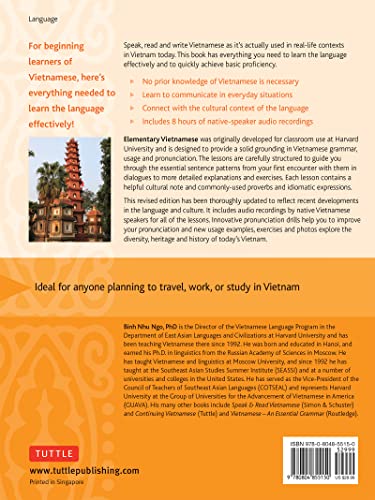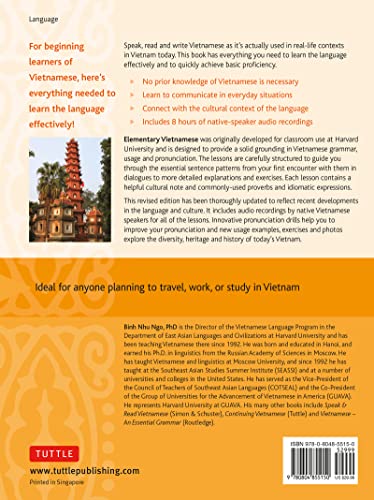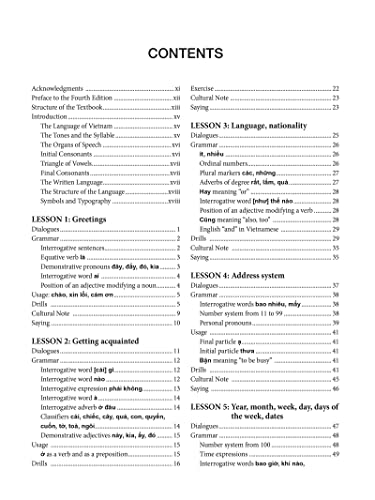




Elementary Vietnamese: Let's Speak Vietnamese, Revised and Updated Fourth Edition (Free Online Audio and Printable Flash Cards)
J**N
Improvement on earlier editions & a solid resource for serious learners
Overall opinion:This is a solid improvement on earlier editions and now the best Vietnamese language resource on the market, and I'd recommend it for anyone who really wants to become good at the language.That said, anyone who just wants to pick up a few basics for the purposes of travel or casual communication with Vietnamese friends or family would be better served by some of the alternative beginners' books IMO. Vietnamese is a challenging language and anyone who's not encountered it before will probably find this book intimidating. The learning curve is indeed very steep, going from nothing to functional at an everyday level in (for the beginner) a *completely* unfamiliar language. However, this level of language is what you would expect a learner in a language like Spanish to have if they were at the elementary level (not the beginner level, note), so in contrast to some other reviewers I would say that the book is setting a realistic target...it's just a plain fact that it's much harder for most English speakers to achieve the basics of Vietnamese than European languages...not the author's fault!Positives:- The speech has been slowed down for many of the conversations compared to the earlier editions, and especially the narratives, which makes listening practice vastly easier.- The grammar and sentence construction explanations are short, simple and to the point. Others have noted that the grammar is crammed into very short explanations in comparison to other languages - well, grammar in Vietnamese is a lot more simple than in other languages, often just a case of adding a word to the sentence in roughly the right place as there are no verb conjugations or anything complex like that. So for most grammar points a very basic explanation is all that's required.- The extensive audio recordings are very useful for getting the sounds of the language right, especially the unfamiliar consonant and vowel sounds and the tones.- The pronunciation guide is very comprehensive, which is a definite plus! Too many books just throw in a short explanation which is totally insufficient. The technical vocabulary might be a bit much for many readers but the recordings of native speakers running through most (all?) of the possible consonant/vowel/tone combinations is extremely helpful.'Areas for improvement' (as teachers would call it these days):- The drills are of marginal value, especially with the answer key not included. I repeat another reviewer's point that it would be much, much better to get rid of the redundant audio recordings of the American woman reading out the grammar explanations (I can read perfectly well for myself, thank you very much) and have native speakers running through the drills so that students can read along, check their answers, or do dictation exercises. For English speakers who don't have any other Asian languages under their belt the more exposure to spoken Vietnamese you can get the better!- The lessons are far too large to treat as a single unit. The conversations introduce masses of vocabulary - chapter 9, for example, introduces around 50 new vocabulary words along with 14 grammar points and 6 usage explanations, which you would expect to take from a few days to a week for most learners to memorise. For most people the lessons will need to be broken up into several sessions so don't expect to get through 14 lessons in 14 sittings!- The focus on Harvard University is just weird. I understand that it was designed for a Harvard course and thus the students would find this topic familiar. However for anyone else it's very strange to be learning about the history and structure of an American university (I'm not an American, even) in a Vietnamese course. Wouldn't it make more sense to learn about a university in HCM or Hanoi...? Very odd indeed.
C**.
Good for people willing to put in a lot of effort
I'm startled by the reviews that are on this book. I am Vietnamese-American, and I wasn't raised speaking Vietnamese. I'm a heritage "speaker" which means that I can understand most of it, but I'm absolutely dreadful at pronouncing Vietnamese words and I didn't learn to read and write it as a child.I finally buckled down in April to work on my Vietnamese. I looked at the reviews of this version of the book as well as other versions. I had my mother (who is 100% Vietnamese) sit down and try to teach me from what we could see in the Look Inside. We bought the book as a result.Was it a struggle? Oh, absolutely. But my Vietnamese has improved by leaps and bounds.To be successful with this textbook:1) Have a native teacher with you. This book is pretty much incomprehensible to anybody who only speaks English and is trying to teach himself. Bonus points for having a native teacher who speaks the Ha Noi dialect. My parents grew up in South Vietnam (for obvious reasons), so they don't actually speak the dialect in which this book is written. Most of the time, it's not a big deal (generally, Sai Gon and Ha Noi dialect speakers can grasp what the other dialect's words mean), but there were a couple of times where both my parents were surprised by some Vietnamese words which were totally new to them.2) Have a ton of patience. Just because you read the dialogue doesn't mean that you'll understand what's going on in it. The vocab is placed after the dialogue in each chapter, and when they start putting in narratives, the vocab is after those, too.I think that if I didn't already understand spoken Vietnamese, learning from this book would've been substantially more difficult. I guess I'd just advise working at a slow pace. This book is used for Year 1 of Vietnamese at Harvard (the author is a Harvard employee), and anybody learning from it should expect the work to take 9+ months.My mother also used to be a French teacher, so she's comfortable taking the role of a language teacher. I learned to read, write, and speak French when I was 7. I've formally studied French, Spanish, Latin, and Mandarin. I have a degree in Spanish. I've learned a smattering of Portuguese and Italian as well, enough to get around. Vietnamese is my eighth written language, I guess, and it's hard (but still a lot easier than Mandarin). I'm really dreadful at tones.Don't pick up this textbook and expect to become fluent in Vietnamese in a day. It's a lengthy process that will take time, dedication, and a lot of studying. If you're not willing to put in the work, don't buy it. But if you sincerely wish to learn Vietnamese and are willing to put in a lot of effort, pick it up.
C**A
Vietnamita
Este livro apresenta 8 diálogos com amplo vocabulário e exercícios, o leitor tem que saber inglês para dar início a aprendizagem vietnamita. O mesmo livro acompanha cd para que o leitor possa ouvir a pronúncia de nativos vietnamitas. E o ouvinte reproduzir a fala.Recomendo a todos
P**N
発音と声調の解説が良いテキスト
日本語で書かれたベトナム語のテキストに比べて、発音と声調などの解説に多くのページを割いています。そこの部分は購入してみないとわからなかった所で、それを知ることが出来た事は良かったと思います。但しレッスン1からは、やはり英語話者向けのテキストですから、思っていたよりも手強いですね。もう1つこの単語の意味さえ分かればとか、解説があれば理解できるのに…、となかなか先へ進めません。しかしながら先が楽しみです。
V**R
Very good for serious, dedicated home study...
...as long as you already have some knowledge of the language. Look, it may be called Elementary Vietnamese, but it's a textbook for a university course, and it's meant to be delivered by a professor who answers questions, demonstrates pronunciation, cajoles, encourages and explains. If you're a complete beginner, you're likely to be overwhelmed, but it's nonetheless good for serious home study, as long as you already have some Vietnamese under your belt, and you're willing to make a considerable effort.(First, a quick paragraph about my knowledge of Vietnamese, so you can better judge my review against your own situation: I'm a native speaker of English, and I also speak fluent French. I've been teaching myself Vietnamese for two-and-a-half years now. I did the 30 Pimsleur Viet lessons (excellent), and I've been through all 105 L-Lingo Viet lessons once (pretty good). I often use the Tuttle Compact English-Viet dictionary, and I also have Quinn's book, Beginner's Vietnamese, but it's dated and slow going. I try, but mostly do not succeed, to read an article in an online Viet newspaper daily. I have also used fun learning aids, such as Sing n' Learn Vietnamese.)The name of the book notwithstanding, Elementary Vietnamese is more advanced than anything else I've used, and it moves at a very rapid pace. For example, whereas Pimsleur lightly touches on tense markers during 30 lessons, Elementary Vietnamese covers them thoroughly, about eight of them, with usage notes, exceptions, etc., in just one lesson, with very little hand-holding. And the book uses proper terminology for everything, as a course textbook should, so be prepared for predicates, relative subordinate clauses, velar fricatives and the like. It introduces new words at a furious clip, but as a home learner, you of course have the option of taking your time.A few practical notes: The book has fifteen chapters. The first fourteen chapters introduce basic grammatical structures and lots of vocabulary. Each chapter has a dialogue or three or four, a vocabulary list, grammar instruction, usage notes, a proverb, interesting (and useful) cultural notes, and lots of drills and exercises. The final chapter, divided into eight units, covers pronunciation. There is also a fairly extensive V-E and E-V glossary at the end. That's crucial, because the drills and exercises lean heavily on the vocabulary you've learned, and if you constantly had to flip through previous pages, randomly searching for a word you'd forgotten, you'd be in trouble. The book also comes with a very good CD that contains numerous recordings (more about the recordings later).On the whole, the book does a good job of presenting basic structure and grammar, and explaining numerous aspects of the language, such as qualifiers, ways of asking questions, the ever-thorny problem of how to address people, usage, pluralisation, tense markers and time, numbers, word formation, making requests, placement of adjectives and adverbs and the effect on meaning, etc. And at twenty pages, almost an hour of recorded instruction and 1.5 hours of recorded drills, it has the best (though very technical) pronunciation guide I've run into yet. The pronunciation section also has drawings to show how you should pronounce various sounds.If you're a complete beginner, however, you'll likely feel lost, even if you try to go slowly. Learning Vietnamese is not like learning French, at least not for me. It's not so much the grammar or vocabulary or tones, but the method of expression. French and English speakers express themselves in essentially the same manner, and share lots of vocabulary. Not so Vietnamese. And it's difficult to teach that to home learners through a book.In addition, the level of technical detail about pronunciation is far beyond what a true beginner needs, or can even understand. But the thing is, you don't absolutely have to pay too much attention to that: the pronunciation drills are excellent, and the speakers in the recordings are clear (though they speak rapidly). Who cares if you understand the notion of the voiced glottal fricative? Just imitate the guy/woman in the recordings.With regard to the recordings, there are about 175 of them, in MP3 format (and I'd swear the main male demonstrator is the same person who did the Pimsleur recordings). The recordings include everything from sample dialogues, new vocabulary, grammar notes, usage instruction and pronunciation guide/exercises. The grammar notes and usage recordings are word-for-word readings of a considerable portion of the textbook, which might seem odd, but it has the advantage of making the course semi-portable. I can re-fresh my memory by listening to a lesson on the train, for example. However, it doesn't always work terrifically well as a portable audio course, since it really wasn't designed that way. As I mentioned at the top, it's a course that was designed to be given by a professor to students who have the book open in front of them.There are tons of exercises in the book, which is great, and you can write to Tuttle to get the answer key. Unfortunately, the answer key is slender, and only contains answers to a limited number of exercises. Tuttle, the publisher, would probably respond that you don't need an answer key to all of the very simple drills, but I think that's an error: they underestimate how difficult it is to be a home learner, with no one to answer your questions. But there once again, let's be clear: this is primarily a course textbook. If you're using it for home study, you've got to expect that it can't respond to your every need, and that in some respects, you're on your own.Starting in chapter seven, there are narrative sections to introduce vocabulary. These are sizable chunks of text (in the book and in the recordings) that would be daunting for the complete beginner, but I find that the narratives are a good opportunity to listen to a person speak at length in Vietnamese, with the text laid out in front of me. A male and a female reader read the text, and I find that I learn a lot by listening and re-listening while following along. There are quite a few a-ha! moments, as I realise `that's how you say that!' I've only done two narratives so far, but they've been very helpful. Sooner or later, I'll take a crack at listening and writing down the text without looking at the book - a homemade dictée. Still, it's not for the complete beginner. There is vocabulary help for the narratives, but no translation. It might be nice if Tuttle included a complete translation of a few of the narratives in the answer key. Interestingly, one of the readings is a poem, which is a nice touch, and pretty rare for Viet instructional material. Some of the narratives are also original newspaper clippings.I know it's vitally important for many people to know whether the book teaches Northern or Southern pronunciation. To me, this is a non-issue, as most of us will be lucky to master a halfway decent pronunciation of anything, never mind the regional differences, but for what it's worth, and as the intro explains, it mostly uses Northern pronunciation, the superset of the language, but actually does a good job of pointing out North/South differences where they're important.For me, this is a very useful book, and the perfect complement to my other studies. I'm about halfway through the first fourteen chapters, and I've been through the pronunciation chapter several times. But it's really not for the complete beginner. It's a generally thorough book, but there are nonetheless times that I want to raise my hand and ask a question, as the instruction can be cursory, and assumes that you are very quick on the uptake. I would strongly suggest doing all 30 Pimsleur lessons before beginning Elementary Vietnamese. Pimsleur has almost no written material at all, so the two systems complement each other nicely. Mind you, Pimsleur is quite pricey by comparison.I'd give it 4.5 stars, but Amazon doesn't do halves, so four out of five.
P**I
Recomendo
Magnifico livro para quem deseja aprender o idioma. Para mim o melhor no aprendizado deste idioma.
A**R
Four Stars
awesome!
Trustpilot
1 day ago
2 weeks ago